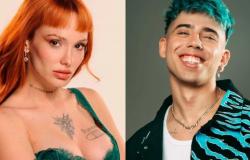By Gerónimo Pose | @geronimo.pose
He had the face of an angel and the eyes of an alien. He was Australia’s best guitarist, says Nick Cave, who met him studying painting at the Caufield Institute of Technology. He wrote “Shivers” at age sixteen, automatically making him a legend.
He was born in Melbourne on October 24, 1959.
He learned to play the piano at a young age and it is said that he only went to a couple of guitar classes, abandoning them after buying a book of chords and teaching himself the operation and the secrets hidden in that body with a neck, a headstock and six strings. His first group was The Young Charlatans with whom he achieved some popularity in his area and recorded a few demos, but they quickly disbanded.
In 1978 he joined the Boys Next Door, with the infamous Tracy Pew on bass, Mick Harvey on guitar, Phil Clavert on drums and Mr. Cave on vocals. With a single LP titled Door, Door In 1979, the band achieved commercial success with “Shivers”, written by Rowland, despite the song having been banned from several radio stations for dealing with topics such as suicide.
The group embarked on an adventure to London, where the underground scene was boiling after the last death throes of punk. With one-way tickets, they lived in a one-room house, all with their respective partners. They changed the band’s name to The Birthday Party and embarked on a self-destructive trip of violent songs and live performances, illness, drugs and self-discovery.
That house had its windows broken by the stones that the neighbors threw at them when they realized that a small group of young punks had invaded the neighborhood. The door was directly coal since it had been set on fire about three times (that they remember). House full of morphine-addicted and heroin-addicted angels who sought to drown, to abstract themselves from a world that was not built for them. Influenced by the Stooges and Jacques Brel, The Birthday Party were really aggressive, there was no one like them.
The live performances are extremely remembered, even a few months ago the departure of Mutiny in Heaven (2023) documentary that covers the history of the group and its particularities, showing, in addition to interviews with its members (those left alive), spectacular archive material. There are Mick, Rowland and Cave dressed as gothic heroes while Tracy Pew seemed like a monolith brought from another planet within the group, dressed as if he were a cowboy from a low-budget western. With his respective hat, mustache and tight jeans he was undoubtedly the Alma mater As for the group’s discordant aesthetic, playing the bass completely exorcised, almost always ending up lying on the floor, who knows if because of having completely entered into a musical trance or because of his elegant addiction to heroin and alcohol.
There, in London, they achieved some recognition—they toured the United States, Europe and Australia with Misfits—but that wasn’t enough. The horizon was broad, as was the collective madness they managed. They all ended up moving to Berlin, where they developed a dissonant style, a mixture of no wave and schizophrenic post punk. The lyrics remained consistent with their sound, dealing with themes such as suicide, incest, bats, murder and various ways of carrying it out. And the blood: product of syringes used more than they should. They released three albums, until the relationship between Cave and Howard was unsustainable. Pew’s vices and imprisonment had, of course, something to do with this separation of the group in 1983.
Rowland was an extraordinary guitarist, an original player of his instrument. It would not be difficult for him to be accepted into another group or even for him to create one himself, as happened later. Although his work is not extensive, his creative capacity broke the mold. Punk and all that style rather ignorant
, almost innocent at one point, was just fading (mainly since the death of Sid Vicious). Therefore, the appearance of someone with such mastery of the instrument deserves to be remembered more than it currently is.
In addition to being an excellent guitarist and playing the piano, he was a great lyricist. In his solo works and in his other bands, it is clear. Before, perhaps somewhat overshadowed by the monstrous compositional capacity of Mr. Nick Cave. “Shivers”, a song that can live up to the matilda waltzing in Australian popular culture it was written by Rowland at the age of sixteen. A topic that she begins by saying that she was contemplating suicide, but that is not her style. She generates in her verses an emotional atmosphere that explodes in the limited chorus and the repetition of ““Down My Spine” with its respective reverb chorus, beautifully executed by Cave on Boys Next Door’s first LP.
Crime & the City Solution was an Australian rock band that had disbanded in 1979. With only a few demos and home recordings, they boasted a special lineup and an abrasive sound that seduced some members of The Birthday Party such as Mick Harvey and Howard himself. . Led by Simon Bonney, they recorded Room of Lights (1986), a vampy punk and blues parade. A curious fact is that Wim Wenders chose a song from this album, the faded Six Bells Chime, for his film The sky over Berlin (1987) where the band even makes a cameo as an ensemble playing in a club.
The group had a short but intense career until its dissolution in 1986. That’s when Howard met Nikki Sudden and he managed to be included on the album I Knew Buffalo Bill (1987), a cult work in which Sudden, Jeffrey Lee Pierce, among others, participated. Also in that year they recorded with Sudden the magnificent Kiss You Kidnapped Charabanc (1987).
He returned to Berlin and formed (what for me is) his best creation, the band These Inmortal Souls, together with Genevieve McGuckin, his partner at the time. Howard wrote the lyrics and decided, once and for all, to sing them. Maybe he had no choice or because of a strange impulse that pushed him to take the microphone.
A monotonous, tired and unregistered voice launched verses of extreme dark lucidity. His first album, Get Lost (Don’t Lie!), edited by Mute, is an ode to love, narrative constructions, detachment from oneself and violence. There are different live recordings that can be found on YouTube showing These Immortal Souls as a group capable of crushing the public.
There are elements that are inherited from The Birthday Party, but there is a certain seasoning that differentiates them. The introductions are sometimes longer, the acoustic guitar is included—a milestone for a band with certain post-punk traits—and there are even songs like “Hey! Little Child” that sound from beyond the grave.
Lydia Lunch, Howard and Genevieve McGuckin had decided to go into the studio to record an album that had some very gruesome sessions. It is unknown if Cave and Howard had mended their relationship, the truth is that Cave himself and Mick Harvey helped in its recording. The recordings were named after Honeymoon in Red, but this saw the light years later thanks to the efforts of Lydia Lunch, who at that point was already an icon in culture. no wave.
It is said that they were nightmarish sessions, to the point where Harvey and Cave asked not to be credited for whatever came of them. Only a Lunch and Howard single managed to be released at the time with a ghostly version of “Some Velvet Morning”, originally written and sung by Nancy Sinatra and Lee Hazlewood.
On the cover they are both hugging, barely covered by a sheet that covers their breasts. The made-up faces, Lydia’s defiant look and Rowland’s angel eyes. This composition contains pianos, flashes of guitars that are too characteristic at this point (something like the screams of a crouching beast), childish percussion, a serious and unusual interpretation by Rowland, and the participation of Lydia Lunch in the choirs that, together with the anecdotal recording sessions, surrounds the song with a strange mysticism.
Nick Cave and Rowland Howard
These Immortal Souls ran until the mid-90s. From then on, he dedicated all his efforts to building his solo career, which only had two albums. In 1995 he returned to Melbourne, where he married Jane Usher. Teenage Snuff Film (1999), where is the song “Dead Radio”, a beautiful portrait of a dysfunctional relationship, with orchestral arrangements, electric guitar plucks and an eclectic rhythm that surrounds the song.
Like his version of “White Wedding,” composed by Billy Idol, and the explosive “She Cried,” which features a fascinating live version featuring Rowland dressed in a pink shirt, singing with his eyes closed and his guitar dangling. at the height of his knees completely dejected. AND Pop Crimes
(2009), where the song that gives the album its title begins with a drum beat and a bass line that dance in unison awaiting the entrance of the guitar that appears with such elegance that it would surprise anyone. A song that extends its sonic trip for seven minutes and begins with a question: Are you Stalin’s secret daughter?
There were two guitars throughout his career that mainly accompanied him. A Gibson Firebird by Ibanez that he used until mid-78 and a Fender Jaguar (model from the late 60s) that was then his favorite until the last moments of his life. That Jaguar, white in color and phosphorescent green details on its body, is seen in practically all the presentations he made live and serves as evidence that Rowland loved that model. As
frontman He took an austere posture, limiting himself to the initial greeting and singing close to the microphone stand. But that way of handling the instrument was quite an event.
The cause of death of the angel with alien eyes, capable of causing a car crash with his guitar – as Patti Smith would have wanted – was liver cancer. In the early 2000s, Howard suffered from hepatitis C and it is said that the medications gradually weakened his physical abilities. His addiction to heroin in his glory years took a toll on him. In those years he performed at some festivals and venues from Australia.
His illness was public knowledge and seeing him on stage was a milestone. The public forgave him for the pifies, the couplings and when he forgot the lyrics. He played for the last time a month before he died, at a Melbourne bar called The Prince, evidently already very ill, where those who were present that day remember him making many jokes about it. The liver transplant never came and to Nicanor Parra’s remembered verse regarding Bolaño’s death one could add, “we owe a liver to Bolaño and Rowland S. Howard.” He died on December 30, 2009, two months after releasing his second album.






